The Role of ICT in the Tourism Industry: A Comprehensive Analysis
VerifiedAdded on 2020/10/05
|14
|4231
|418
Report
AI Summary
This report provides a comprehensive analysis of the impact of Information and Communication Technologies (ICT) on the tourism industry. It begins with an introduction to ICT and innovation, then explores the historical development of ICT and relevant technological innovation theories, including Schumpeter's theory and Porter's Five Forces model. The report examines the relationship between technological development and tourism, focusing on how ICT has transformed the industry, increased competitiveness, and influenced the changing structure of the travel and tourism sector. The report also discusses the application of ICT4D and the diffusion of innovation in the tourism sector. The report concludes with an evaluation of the competitiveness of the tourism industry in the context of technological advancements and offers insights into the future of ICT in tourism, emphasizing its role in enhancing customer approach, improving performance, and gaining a competitive advantage.
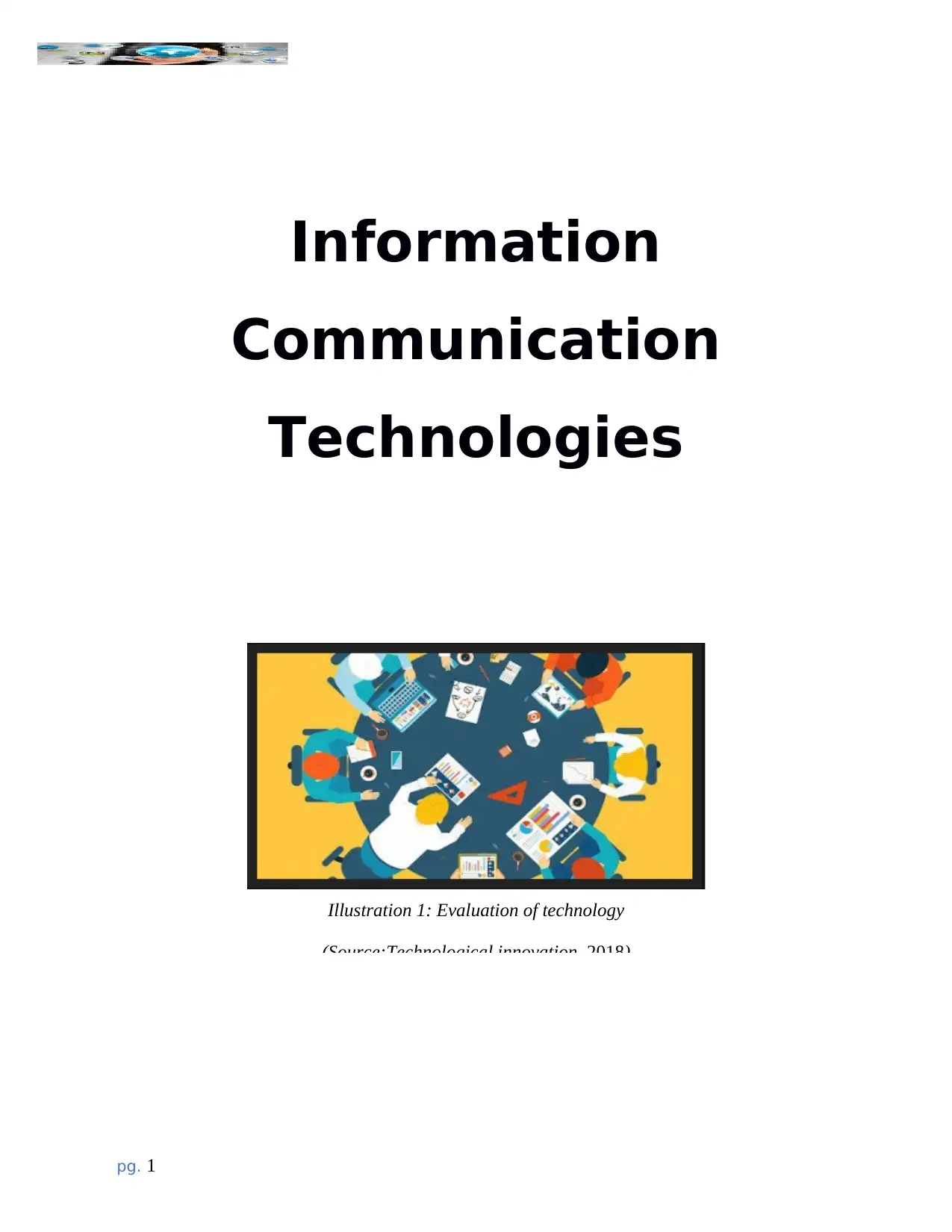
Information
Communication
Technologies
pg. 1
Illustration 1: Evaluation of technology
(Source:Technological innovation, 2018)
Communication
Technologies
pg. 1
Illustration 1: Evaluation of technology
(Source:Technological innovation, 2018)
Paraphrase This Document
Need a fresh take? Get an instant paraphrase of this document with our AI Paraphraser
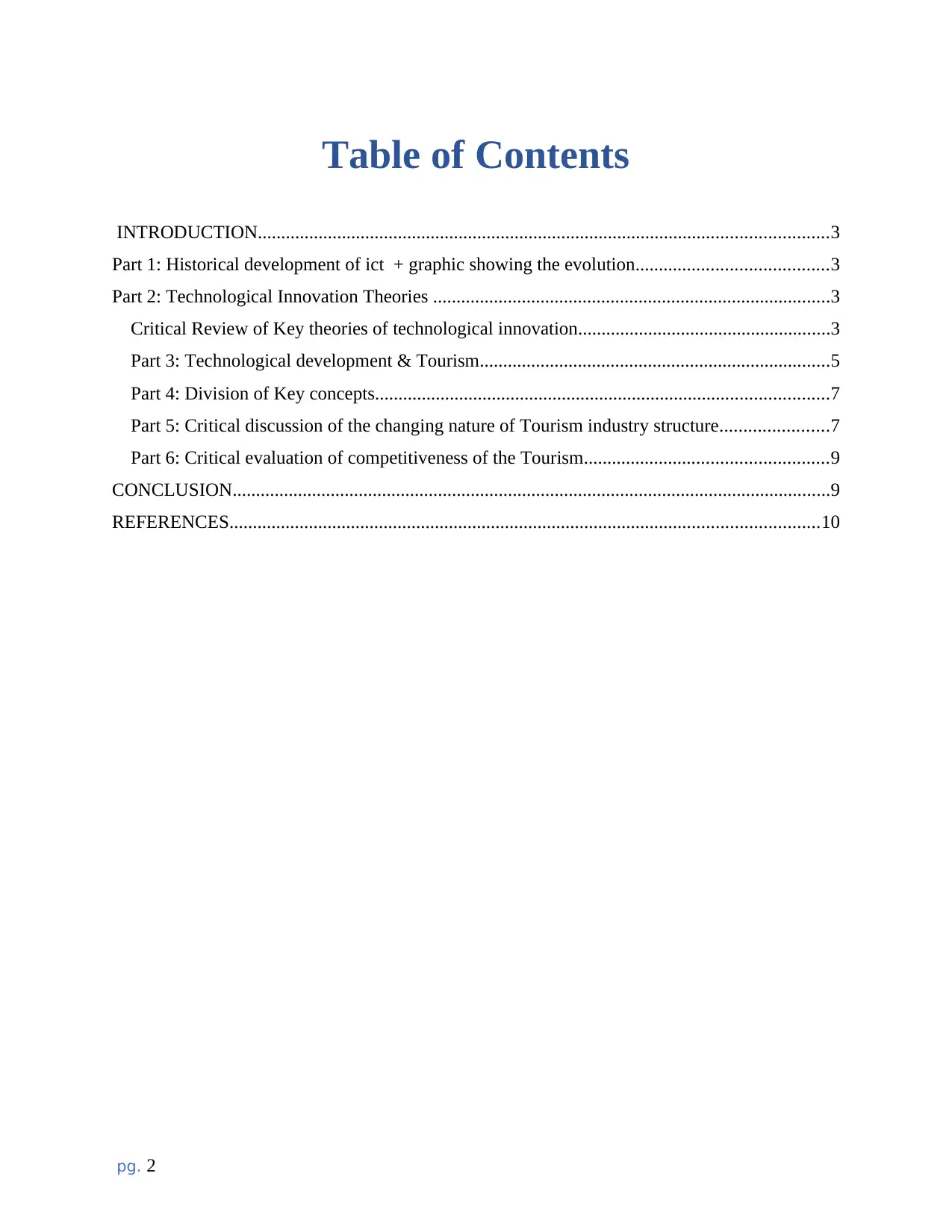
Table of Contents
INTRODUCTION..........................................................................................................................3
Part 1: Historical development of ict + graphic showing the evolution.........................................3
Part 2: Technological Innovation Theories .....................................................................................3
Critical Review of Key theories of technological innovation......................................................3
Part 3: Technological development & Tourism...........................................................................5
Part 4: Division of Key concepts.................................................................................................7
Part 5: Critical discussion of the changing nature of Tourism industry structure.......................7
Part 6: Critical evaluation of competitiveness of the Tourism....................................................9
CONCLUSION................................................................................................................................9
REFERENCES..............................................................................................................................10
pg. 2
INTRODUCTION..........................................................................................................................3
Part 1: Historical development of ict + graphic showing the evolution.........................................3
Part 2: Technological Innovation Theories .....................................................................................3
Critical Review of Key theories of technological innovation......................................................3
Part 3: Technological development & Tourism...........................................................................5
Part 4: Division of Key concepts.................................................................................................7
Part 5: Critical discussion of the changing nature of Tourism industry structure.......................7
Part 6: Critical evaluation of competitiveness of the Tourism....................................................9
CONCLUSION................................................................................................................................9
REFERENCES..............................................................................................................................10
pg. 2
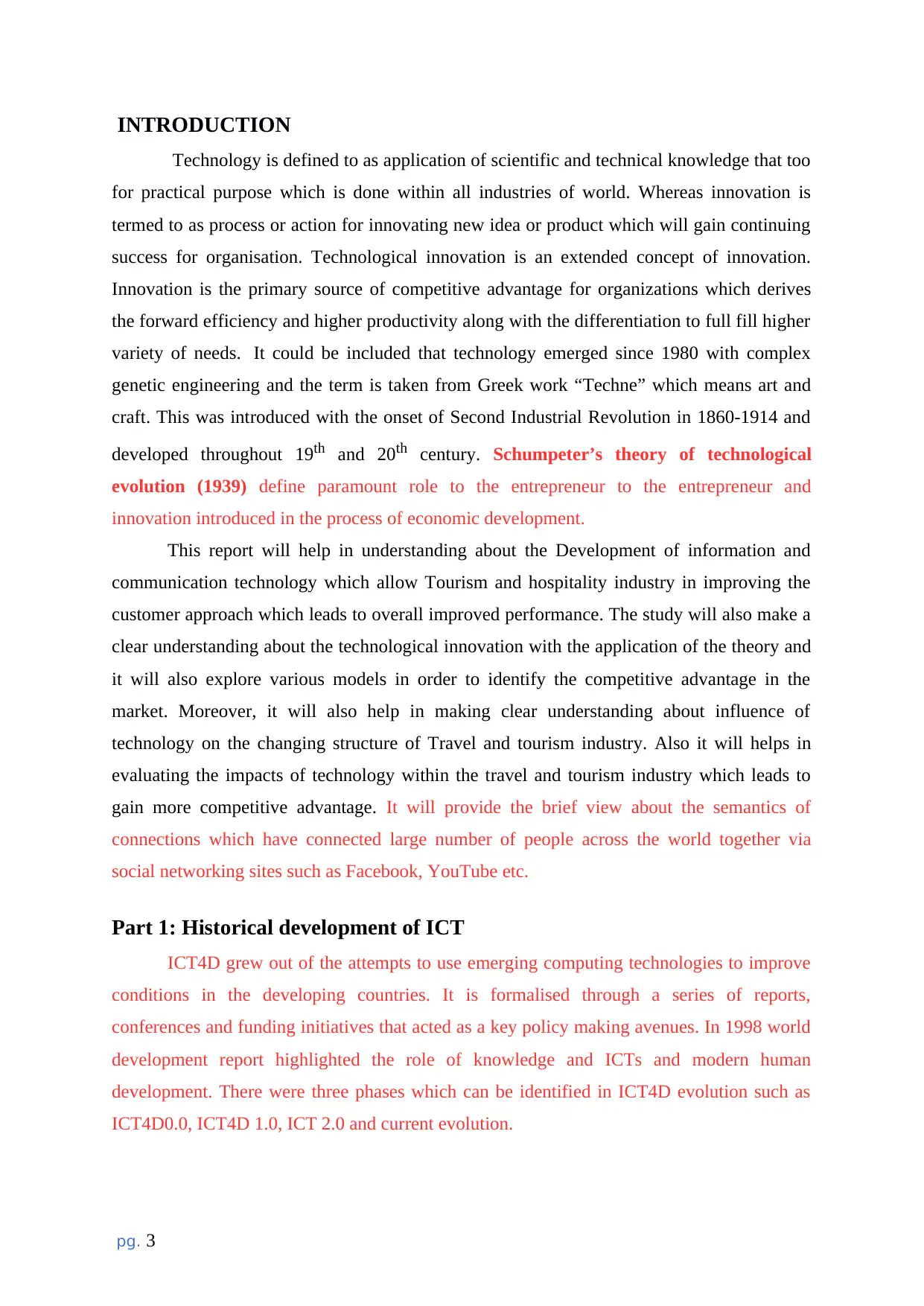
INTRODUCTION
Technology is defined to as application of scientific and technical knowledge that too
for practical purpose which is done within all industries of world. Whereas innovation is
termed to as process or action for innovating new idea or product which will gain continuing
success for organisation. Technological innovation is an extended concept of innovation.
Innovation is the primary source of competitive advantage for organizations which derives
the forward efficiency and higher productivity along with the differentiation to full fill higher
variety of needs. It could be included that technology emerged since 1980 with complex
genetic engineering and the term is taken from Greek work “Techne” which means art and
craft. This was introduced with the onset of Second Industrial Revolution in 1860-1914 and
developed throughout 19th and 20th century. Schumpeter’s theory of technological
evolution (1939) define paramount role to the entrepreneur to the entrepreneur and
innovation introduced in the process of economic development.
This report will help in understanding about the Development of information and
communication technology which allow Tourism and hospitality industry in improving the
customer approach which leads to overall improved performance. The study will also make a
clear understanding about the technological innovation with the application of the theory and
it will also explore various models in order to identify the competitive advantage in the
market. Moreover, it will also help in making clear understanding about influence of
technology on the changing structure of Travel and tourism industry. Also it will helps in
evaluating the impacts of technology within the travel and tourism industry which leads to
gain more competitive advantage. It will provide the brief view about the semantics of
connections which have connected large number of people across the world together via
social networking sites such as Facebook, YouTube etc.
Part 1: Historical development of ICT
ICT4D grew out of the attempts to use emerging computing technologies to improve
conditions in the developing countries. It is formalised through a series of reports,
conferences and funding initiatives that acted as a key policy making avenues. In 1998 world
development report highlighted the role of knowledge and ICTs and modern human
development. There were three phases which can be identified in ICT4D evolution such as
ICT4D0.0, ICT4D 1.0, ICT 2.0 and current evolution.
pg. 3
Technology is defined to as application of scientific and technical knowledge that too
for practical purpose which is done within all industries of world. Whereas innovation is
termed to as process or action for innovating new idea or product which will gain continuing
success for organisation. Technological innovation is an extended concept of innovation.
Innovation is the primary source of competitive advantage for organizations which derives
the forward efficiency and higher productivity along with the differentiation to full fill higher
variety of needs. It could be included that technology emerged since 1980 with complex
genetic engineering and the term is taken from Greek work “Techne” which means art and
craft. This was introduced with the onset of Second Industrial Revolution in 1860-1914 and
developed throughout 19th and 20th century. Schumpeter’s theory of technological
evolution (1939) define paramount role to the entrepreneur to the entrepreneur and
innovation introduced in the process of economic development.
This report will help in understanding about the Development of information and
communication technology which allow Tourism and hospitality industry in improving the
customer approach which leads to overall improved performance. The study will also make a
clear understanding about the technological innovation with the application of the theory and
it will also explore various models in order to identify the competitive advantage in the
market. Moreover, it will also help in making clear understanding about influence of
technology on the changing structure of Travel and tourism industry. Also it will helps in
evaluating the impacts of technology within the travel and tourism industry which leads to
gain more competitive advantage. It will provide the brief view about the semantics of
connections which have connected large number of people across the world together via
social networking sites such as Facebook, YouTube etc.
Part 1: Historical development of ICT
ICT4D grew out of the attempts to use emerging computing technologies to improve
conditions in the developing countries. It is formalised through a series of reports,
conferences and funding initiatives that acted as a key policy making avenues. In 1998 world
development report highlighted the role of knowledge and ICTs and modern human
development. There were three phases which can be identified in ICT4D evolution such as
ICT4D0.0, ICT4D 1.0, ICT 2.0 and current evolution.
pg. 3
⊘ This is a preview!⊘
Do you want full access?
Subscribe today to unlock all pages.

Trusted by 1+ million students worldwide
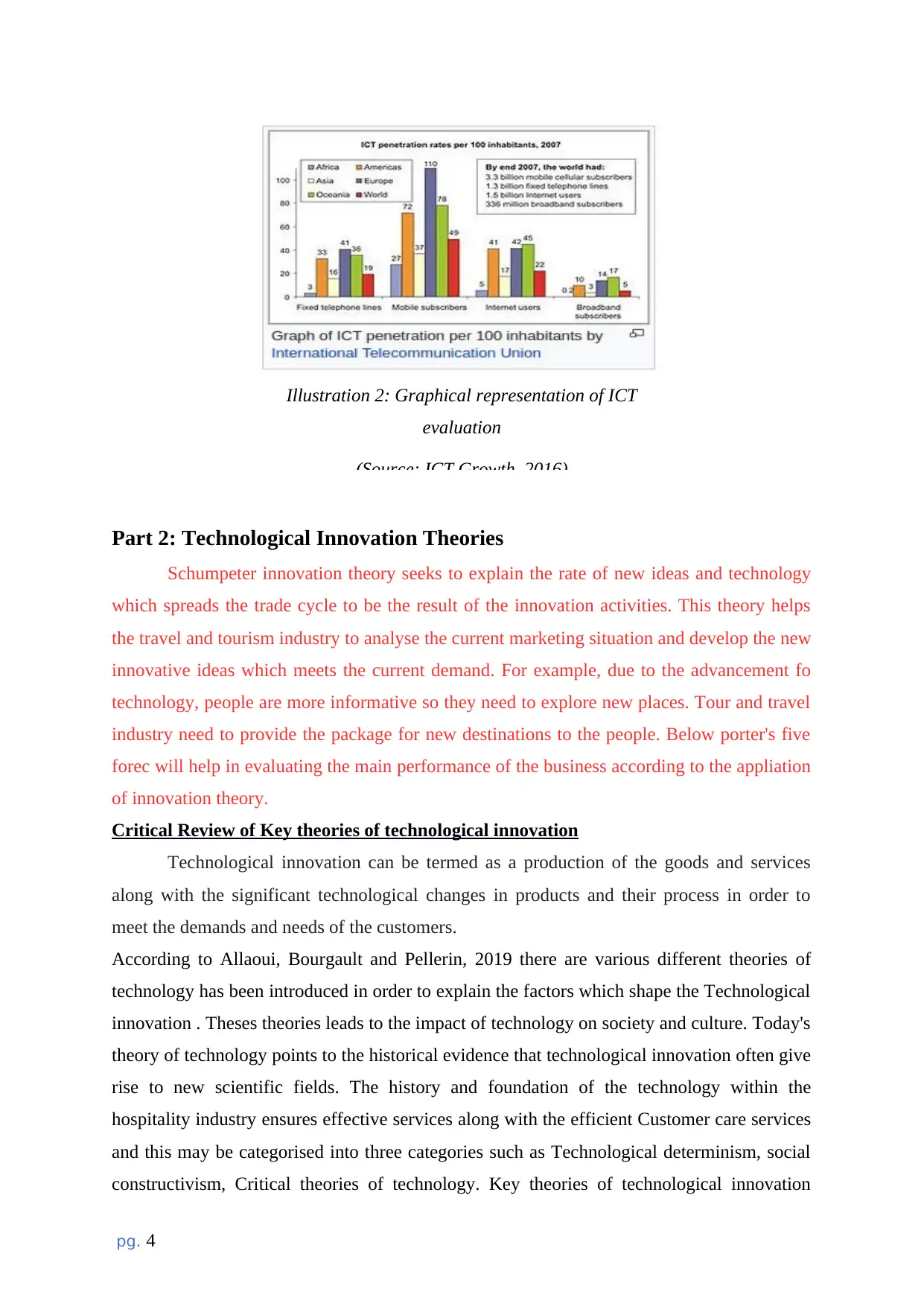
Part 2: Technological Innovation Theories
Schumpeter innovation theory seeks to explain the rate of new ideas and technology
which spreads the trade cycle to be the result of the innovation activities. This theory helps
the travel and tourism industry to analyse the current marketing situation and develop the new
innovative ideas which meets the current demand. For example, due to the advancement fo
technology, people are more informative so they need to explore new places. Tour and travel
industry need to provide the package for new destinations to the people. Below porter's five
forec will help in evaluating the main performance of the business according to the appliation
of innovation theory.
Critical Review of Key theories of technological innovation
Technological innovation can be termed as a production of the goods and services
along with the significant technological changes in products and their process in order to
meet the demands and needs of the customers.
According to Allaoui, Bourgault and Pellerin, 2019 there are various different theories of
technology has been introduced in order to explain the factors which shape the Technological
innovation . Theses theories leads to the impact of technology on society and culture. Today's
theory of technology points to the historical evidence that technological innovation often give
rise to new scientific fields. The history and foundation of the technology within the
hospitality industry ensures effective services along with the efficient Customer care services
and this may be categorised into three categories such as Technological determinism, social
constructivism, Critical theories of technology. Key theories of technological innovation
pg. 4
Illustration 2: Graphical representation of ICT
evaluation
(Source: ICT Growth, 2016)
Schumpeter innovation theory seeks to explain the rate of new ideas and technology
which spreads the trade cycle to be the result of the innovation activities. This theory helps
the travel and tourism industry to analyse the current marketing situation and develop the new
innovative ideas which meets the current demand. For example, due to the advancement fo
technology, people are more informative so they need to explore new places. Tour and travel
industry need to provide the package for new destinations to the people. Below porter's five
forec will help in evaluating the main performance of the business according to the appliation
of innovation theory.
Critical Review of Key theories of technological innovation
Technological innovation can be termed as a production of the goods and services
along with the significant technological changes in products and their process in order to
meet the demands and needs of the customers.
According to Allaoui, Bourgault and Pellerin, 2019 there are various different theories of
technology has been introduced in order to explain the factors which shape the Technological
innovation . Theses theories leads to the impact of technology on society and culture. Today's
theory of technology points to the historical evidence that technological innovation often give
rise to new scientific fields. The history and foundation of the technology within the
hospitality industry ensures effective services along with the efficient Customer care services
and this may be categorised into three categories such as Technological determinism, social
constructivism, Critical theories of technology. Key theories of technological innovation
pg. 4
Illustration 2: Graphical representation of ICT
evaluation
(Source: ICT Growth, 2016)
Paraphrase This Document
Need a fresh take? Get an instant paraphrase of this document with our AI Paraphraser
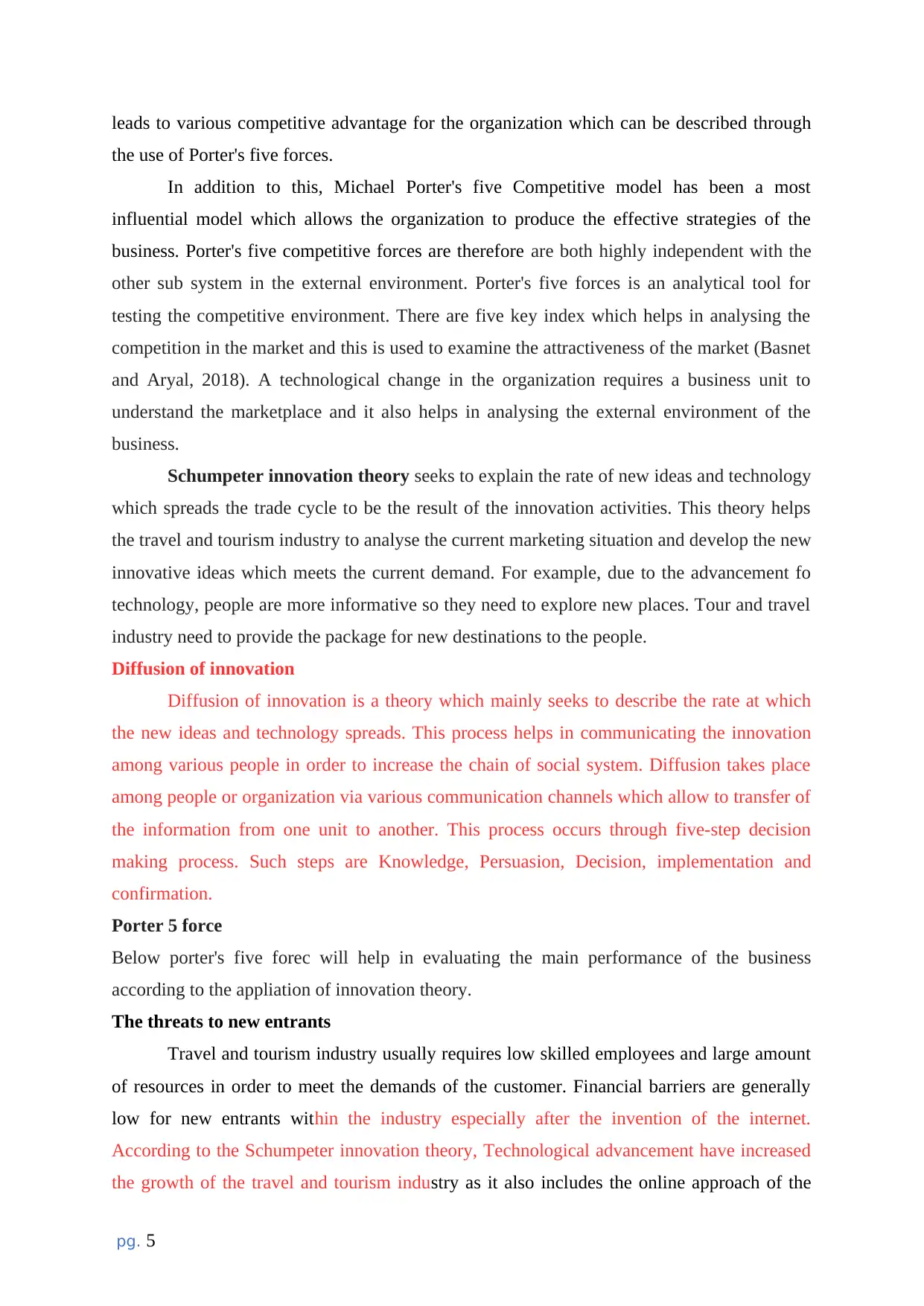
leads to various competitive advantage for the organization which can be described through
the use of Porter's five forces.
In addition to this, Michael Porter's five Competitive model has been a most
influential model which allows the organization to produce the effective strategies of the
business. Porter's five competitive forces are therefore are both highly independent with the
other sub system in the external environment. Porter's five forces is an analytical tool for
testing the competitive environment. There are five key index which helps in analysing the
competition in the market and this is used to examine the attractiveness of the market (Basnet
and Aryal, 2018). A technological change in the organization requires a business unit to
understand the marketplace and it also helps in analysing the external environment of the
business.
Schumpeter innovation theory seeks to explain the rate of new ideas and technology
which spreads the trade cycle to be the result of the innovation activities. This theory helps
the travel and tourism industry to analyse the current marketing situation and develop the new
innovative ideas which meets the current demand. For example, due to the advancement fo
technology, people are more informative so they need to explore new places. Tour and travel
industry need to provide the package for new destinations to the people.
Diffusion of innovation
Diffusion of innovation is a theory which mainly seeks to describe the rate at which
the new ideas and technology spreads. This process helps in communicating the innovation
among various people in order to increase the chain of social system. Diffusion takes place
among people or organization via various communication channels which allow to transfer of
the information from one unit to another. This process occurs through five-step decision
making process. Such steps are Knowledge, Persuasion, Decision, implementation and
confirmation.
Porter 5 force
Below porter's five forec will help in evaluating the main performance of the business
according to the appliation of innovation theory.
The threats to new entrants
Travel and tourism industry usually requires low skilled employees and large amount
of resources in order to meet the demands of the customer. Financial barriers are generally
low for new entrants within the industry especially after the invention of the internet.
According to the Schumpeter innovation theory, Technological advancement have increased
the growth of the travel and tourism industry as it also includes the online approach of the
pg. 5
the use of Porter's five forces.
In addition to this, Michael Porter's five Competitive model has been a most
influential model which allows the organization to produce the effective strategies of the
business. Porter's five competitive forces are therefore are both highly independent with the
other sub system in the external environment. Porter's five forces is an analytical tool for
testing the competitive environment. There are five key index which helps in analysing the
competition in the market and this is used to examine the attractiveness of the market (Basnet
and Aryal, 2018). A technological change in the organization requires a business unit to
understand the marketplace and it also helps in analysing the external environment of the
business.
Schumpeter innovation theory seeks to explain the rate of new ideas and technology
which spreads the trade cycle to be the result of the innovation activities. This theory helps
the travel and tourism industry to analyse the current marketing situation and develop the new
innovative ideas which meets the current demand. For example, due to the advancement fo
technology, people are more informative so they need to explore new places. Tour and travel
industry need to provide the package for new destinations to the people.
Diffusion of innovation
Diffusion of innovation is a theory which mainly seeks to describe the rate at which
the new ideas and technology spreads. This process helps in communicating the innovation
among various people in order to increase the chain of social system. Diffusion takes place
among people or organization via various communication channels which allow to transfer of
the information from one unit to another. This process occurs through five-step decision
making process. Such steps are Knowledge, Persuasion, Decision, implementation and
confirmation.
Porter 5 force
Below porter's five forec will help in evaluating the main performance of the business
according to the appliation of innovation theory.
The threats to new entrants
Travel and tourism industry usually requires low skilled employees and large amount
of resources in order to meet the demands of the customer. Financial barriers are generally
low for new entrants within the industry especially after the invention of the internet.
According to the Schumpeter innovation theory, Technological advancement have increased
the growth of the travel and tourism industry as it also includes the online approach of the
pg. 5
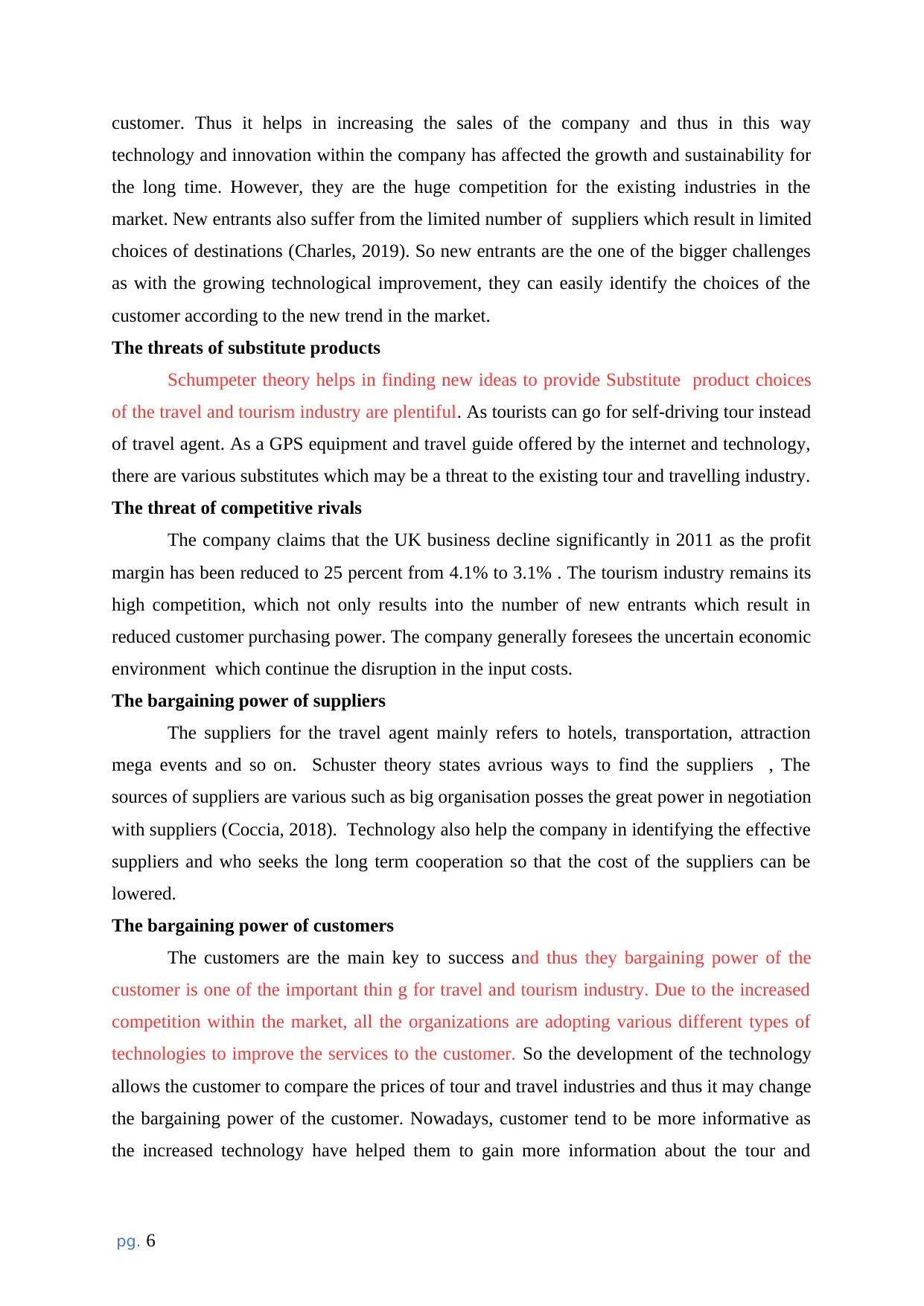
customer. Thus it helps in increasing the sales of the company and thus in this way
technology and innovation within the company has affected the growth and sustainability for
the long time. However, they are the huge competition for the existing industries in the
market. New entrants also suffer from the limited number of suppliers which result in limited
choices of destinations (Charles, 2019). So new entrants are the one of the bigger challenges
as with the growing technological improvement, they can easily identify the choices of the
customer according to the new trend in the market.
The threats of substitute products
Schumpeter theory helps in finding new ideas to provide Substitute product choices
of the travel and tourism industry are plentiful. As tourists can go for self-driving tour instead
of travel agent. As a GPS equipment and travel guide offered by the internet and technology,
there are various substitutes which may be a threat to the existing tour and travelling industry.
The threat of competitive rivals
The company claims that the UK business decline significantly in 2011 as the profit
margin has been reduced to 25 percent from 4.1% to 3.1% . The tourism industry remains its
high competition, which not only results into the number of new entrants which result in
reduced customer purchasing power. The company generally foresees the uncertain economic
environment which continue the disruption in the input costs.
The bargaining power of suppliers
The suppliers for the travel agent mainly refers to hotels, transportation, attraction
mega events and so on. Schuster theory states avrious ways to find the suppliers , The
sources of suppliers are various such as big organisation posses the great power in negotiation
with suppliers (Coccia, 2018). Technology also help the company in identifying the effective
suppliers and who seeks the long term cooperation so that the cost of the suppliers can be
lowered.
The bargaining power of customers
The customers are the main key to success and thus they bargaining power of the
customer is one of the important thin g for travel and tourism industry. Due to the increased
competition within the market, all the organizations are adopting various different types of
technologies to improve the services to the customer. So the development of the technology
allows the customer to compare the prices of tour and travel industries and thus it may change
the bargaining power of the customer. Nowadays, customer tend to be more informative as
the increased technology have helped them to gain more information about the tour and
pg. 6
technology and innovation within the company has affected the growth and sustainability for
the long time. However, they are the huge competition for the existing industries in the
market. New entrants also suffer from the limited number of suppliers which result in limited
choices of destinations (Charles, 2019). So new entrants are the one of the bigger challenges
as with the growing technological improvement, they can easily identify the choices of the
customer according to the new trend in the market.
The threats of substitute products
Schumpeter theory helps in finding new ideas to provide Substitute product choices
of the travel and tourism industry are plentiful. As tourists can go for self-driving tour instead
of travel agent. As a GPS equipment and travel guide offered by the internet and technology,
there are various substitutes which may be a threat to the existing tour and travelling industry.
The threat of competitive rivals
The company claims that the UK business decline significantly in 2011 as the profit
margin has been reduced to 25 percent from 4.1% to 3.1% . The tourism industry remains its
high competition, which not only results into the number of new entrants which result in
reduced customer purchasing power. The company generally foresees the uncertain economic
environment which continue the disruption in the input costs.
The bargaining power of suppliers
The suppliers for the travel agent mainly refers to hotels, transportation, attraction
mega events and so on. Schuster theory states avrious ways to find the suppliers , The
sources of suppliers are various such as big organisation posses the great power in negotiation
with suppliers (Coccia, 2018). Technology also help the company in identifying the effective
suppliers and who seeks the long term cooperation so that the cost of the suppliers can be
lowered.
The bargaining power of customers
The customers are the main key to success and thus they bargaining power of the
customer is one of the important thin g for travel and tourism industry. Due to the increased
competition within the market, all the organizations are adopting various different types of
technologies to improve the services to the customer. So the development of the technology
allows the customer to compare the prices of tour and travel industries and thus it may change
the bargaining power of the customer. Nowadays, customer tend to be more informative as
the increased technology have helped them to gain more information about the tour and
pg. 6
⊘ This is a preview!⊘
Do you want full access?
Subscribe today to unlock all pages.

Trusted by 1+ million students worldwide
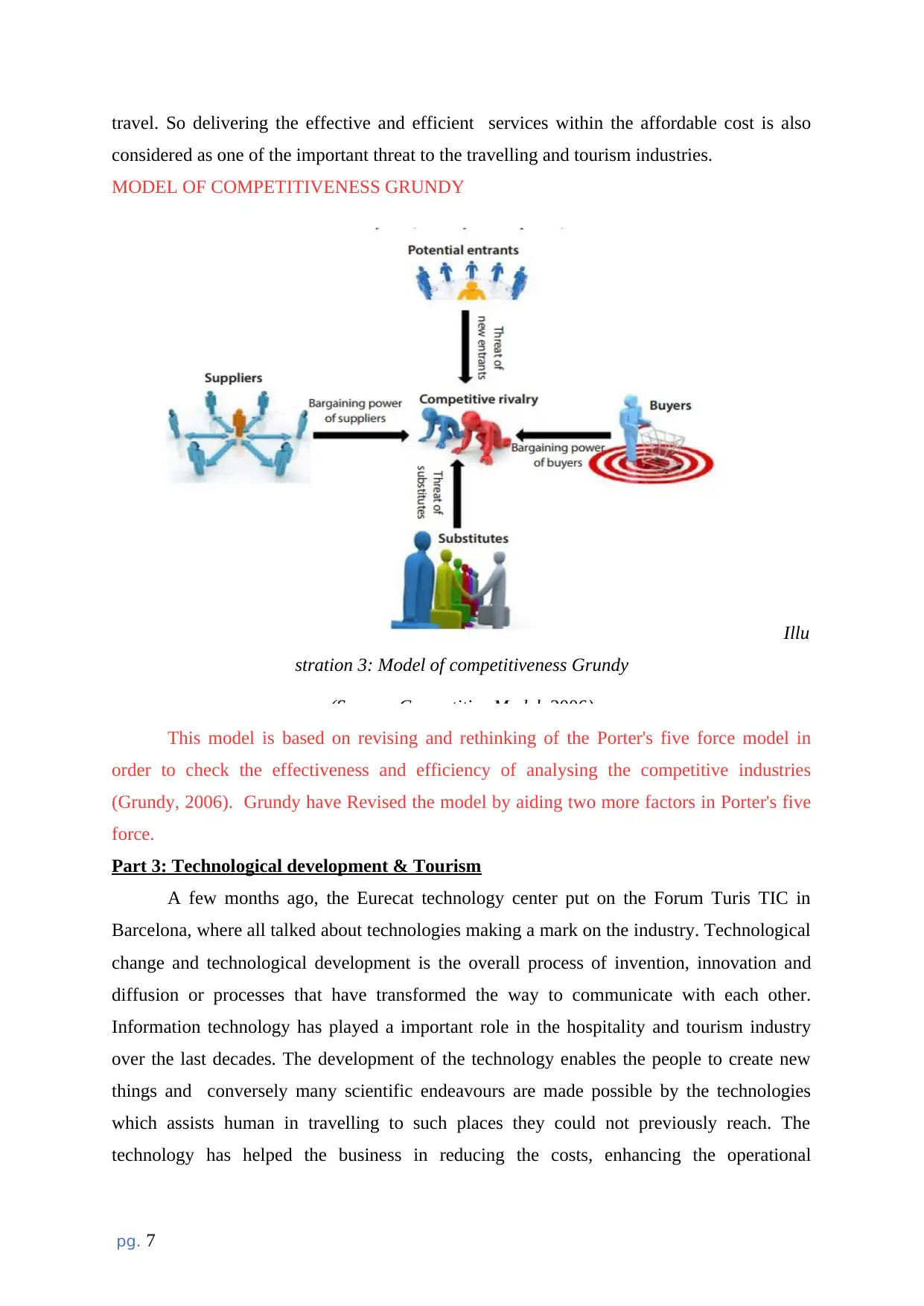
travel. So delivering the effective and efficient services within the affordable cost is also
considered as one of the important threat to the travelling and tourism industries.
MODEL OF COMPETITIVENESS GRUNDY
This model is based on revising and rethinking of the Porter's five force model in
order to check the effectiveness and efficiency of analysing the competitive industries
(Grundy, 2006). Grundy have Revised the model by aiding two more factors in Porter's five
force.
Part 3: Technological development & Tourism
A few months ago, the Eurecat technology center put on the Forum Turis TIC in
Barcelona, where all talked about technologies making a mark on the industry. Technological
change and technological development is the overall process of invention, innovation and
diffusion or processes that have transformed the way to communicate with each other.
Information technology has played a important role in the hospitality and tourism industry
over the last decades. The development of the technology enables the people to create new
things and conversely many scientific endeavours are made possible by the technologies
which assists human in travelling to such places they could not previously reach. The
technology has helped the business in reducing the costs, enhancing the operational
pg. 7
Illu
stration 3: Model of competitiveness Grundy
(Source: Competitive Model, 2006)
considered as one of the important threat to the travelling and tourism industries.
MODEL OF COMPETITIVENESS GRUNDY
This model is based on revising and rethinking of the Porter's five force model in
order to check the effectiveness and efficiency of analysing the competitive industries
(Grundy, 2006). Grundy have Revised the model by aiding two more factors in Porter's five
force.
Part 3: Technological development & Tourism
A few months ago, the Eurecat technology center put on the Forum Turis TIC in
Barcelona, where all talked about technologies making a mark on the industry. Technological
change and technological development is the overall process of invention, innovation and
diffusion or processes that have transformed the way to communicate with each other.
Information technology has played a important role in the hospitality and tourism industry
over the last decades. The development of the technology enables the people to create new
things and conversely many scientific endeavours are made possible by the technologies
which assists human in travelling to such places they could not previously reach. The
technology has helped the business in reducing the costs, enhancing the operational
pg. 7
Illu
stration 3: Model of competitiveness Grundy
(Source: Competitive Model, 2006)
Paraphrase This Document
Need a fresh take? Get an instant paraphrase of this document with our AI Paraphraser
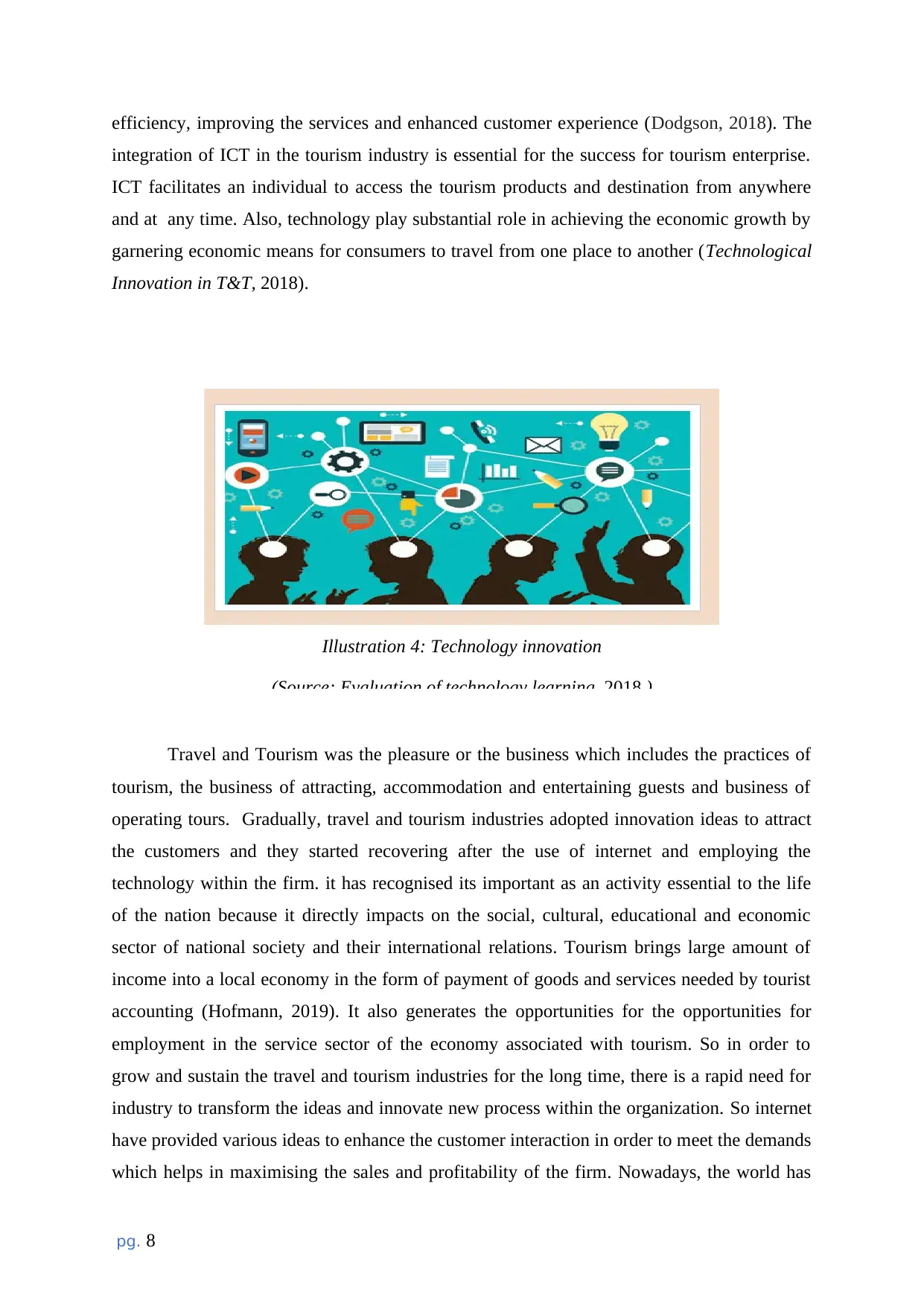
efficiency, improving the services and enhanced customer experience (Dodgson, 2018). The
integration of ICT in the tourism industry is essential for the success for tourism enterprise.
ICT facilitates an individual to access the tourism products and destination from anywhere
and at any time. Also, technology play substantial role in achieving the economic growth by
garnering economic means for consumers to travel from one place to another (Technological
Innovation in T&T, 2018).
Travel and Tourism was the pleasure or the business which includes the practices of
tourism, the business of attracting, accommodation and entertaining guests and business of
operating tours. Gradually, travel and tourism industries adopted innovation ideas to attract
the customers and they started recovering after the use of internet and employing the
technology within the firm. it has recognised its important as an activity essential to the life
of the nation because it directly impacts on the social, cultural, educational and economic
sector of national society and their international relations. Tourism brings large amount of
income into a local economy in the form of payment of goods and services needed by tourist
accounting (Hofmann, 2019). It also generates the opportunities for the opportunities for
employment in the service sector of the economy associated with tourism. So in order to
grow and sustain the travel and tourism industries for the long time, there is a rapid need for
industry to transform the ideas and innovate new process within the organization. So internet
have provided various ideas to enhance the customer interaction in order to meet the demands
which helps in maximising the sales and profitability of the firm. Nowadays, the world has
pg. 8
Illustration 4: Technology innovation
(Source: Evaluation of technology learning. 2018.)
integration of ICT in the tourism industry is essential for the success for tourism enterprise.
ICT facilitates an individual to access the tourism products and destination from anywhere
and at any time. Also, technology play substantial role in achieving the economic growth by
garnering economic means for consumers to travel from one place to another (Technological
Innovation in T&T, 2018).
Travel and Tourism was the pleasure or the business which includes the practices of
tourism, the business of attracting, accommodation and entertaining guests and business of
operating tours. Gradually, travel and tourism industries adopted innovation ideas to attract
the customers and they started recovering after the use of internet and employing the
technology within the firm. it has recognised its important as an activity essential to the life
of the nation because it directly impacts on the social, cultural, educational and economic
sector of national society and their international relations. Tourism brings large amount of
income into a local economy in the form of payment of goods and services needed by tourist
accounting (Hofmann, 2019). It also generates the opportunities for the opportunities for
employment in the service sector of the economy associated with tourism. So in order to
grow and sustain the travel and tourism industries for the long time, there is a rapid need for
industry to transform the ideas and innovate new process within the organization. So internet
have provided various ideas to enhance the customer interaction in order to meet the demands
which helps in maximising the sales and profitability of the firm. Nowadays, the world has
pg. 8
Illustration 4: Technology innovation
(Source: Evaluation of technology learning. 2018.)
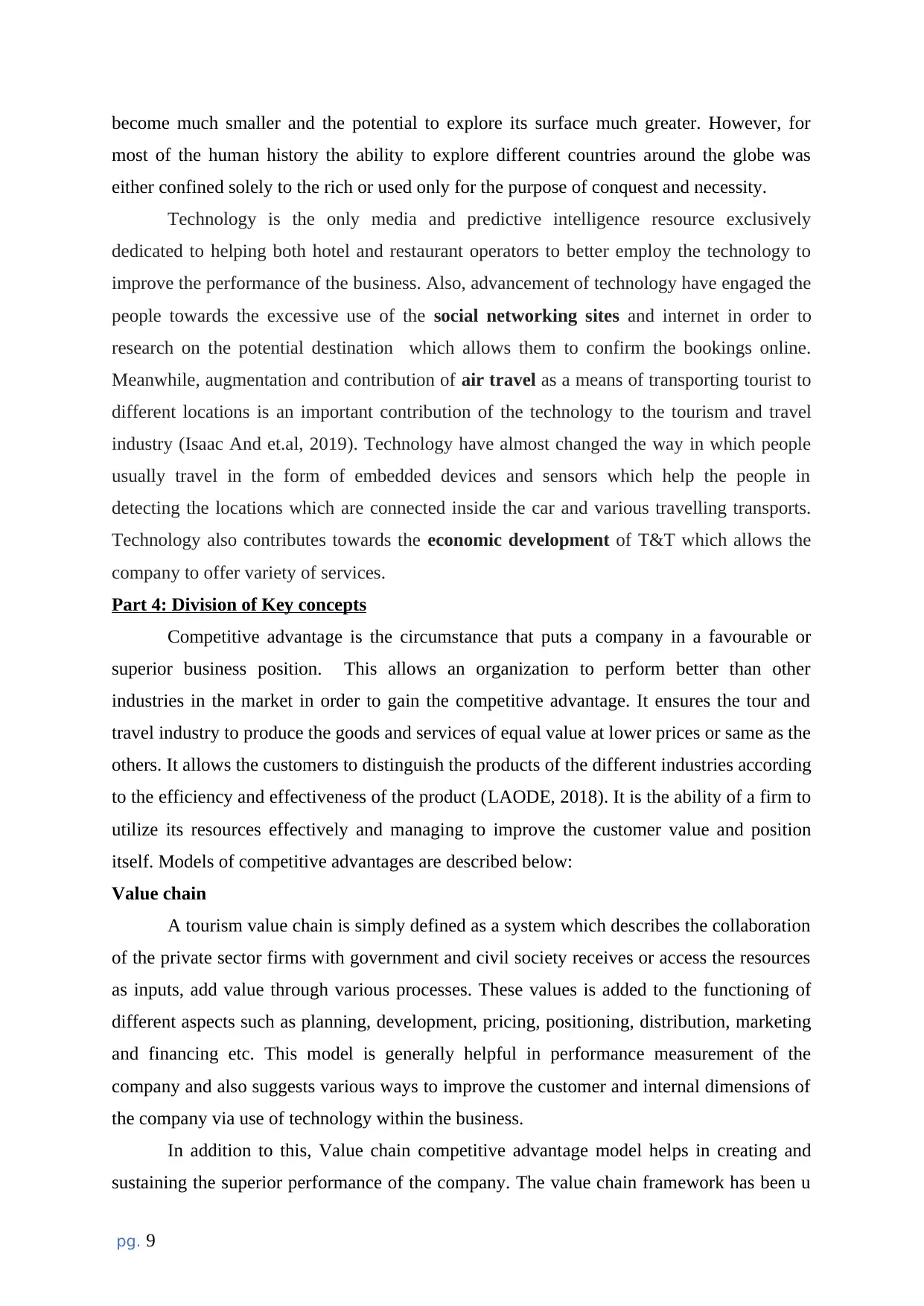
become much smaller and the potential to explore its surface much greater. However, for
most of the human history the ability to explore different countries around the globe was
either confined solely to the rich or used only for the purpose of conquest and necessity.
Technology is the only media and predictive intelligence resource exclusively
dedicated to helping both hotel and restaurant operators to better employ the technology to
improve the performance of the business. Also, advancement of technology have engaged the
people towards the excessive use of the social networking sites and internet in order to
research on the potential destination which allows them to confirm the bookings online.
Meanwhile, augmentation and contribution of air travel as a means of transporting tourist to
different locations is an important contribution of the technology to the tourism and travel
industry (Isaac And et.al, 2019). Technology have almost changed the way in which people
usually travel in the form of embedded devices and sensors which help the people in
detecting the locations which are connected inside the car and various travelling transports.
Technology also contributes towards the economic development of T&T which allows the
company to offer variety of services.
Part 4: Division of Key concepts
Competitive advantage is the circumstance that puts a company in a favourable or
superior business position. This allows an organization to perform better than other
industries in the market in order to gain the competitive advantage. It ensures the tour and
travel industry to produce the goods and services of equal value at lower prices or same as the
others. It allows the customers to distinguish the products of the different industries according
to the efficiency and effectiveness of the product (LAODE, 2018). It is the ability of a firm to
utilize its resources effectively and managing to improve the customer value and position
itself. Models of competitive advantages are described below:
Value chain
A tourism value chain is simply defined as a system which describes the collaboration
of the private sector firms with government and civil society receives or access the resources
as inputs, add value through various processes. These values is added to the functioning of
different aspects such as planning, development, pricing, positioning, distribution, marketing
and financing etc. This model is generally helpful in performance measurement of the
company and also suggests various ways to improve the customer and internal dimensions of
the company via use of technology within the business.
In addition to this, Value chain competitive advantage model helps in creating and
sustaining the superior performance of the company. The value chain framework has been u
pg. 9
most of the human history the ability to explore different countries around the globe was
either confined solely to the rich or used only for the purpose of conquest and necessity.
Technology is the only media and predictive intelligence resource exclusively
dedicated to helping both hotel and restaurant operators to better employ the technology to
improve the performance of the business. Also, advancement of technology have engaged the
people towards the excessive use of the social networking sites and internet in order to
research on the potential destination which allows them to confirm the bookings online.
Meanwhile, augmentation and contribution of air travel as a means of transporting tourist to
different locations is an important contribution of the technology to the tourism and travel
industry (Isaac And et.al, 2019). Technology have almost changed the way in which people
usually travel in the form of embedded devices and sensors which help the people in
detecting the locations which are connected inside the car and various travelling transports.
Technology also contributes towards the economic development of T&T which allows the
company to offer variety of services.
Part 4: Division of Key concepts
Competitive advantage is the circumstance that puts a company in a favourable or
superior business position. This allows an organization to perform better than other
industries in the market in order to gain the competitive advantage. It ensures the tour and
travel industry to produce the goods and services of equal value at lower prices or same as the
others. It allows the customers to distinguish the products of the different industries according
to the efficiency and effectiveness of the product (LAODE, 2018). It is the ability of a firm to
utilize its resources effectively and managing to improve the customer value and position
itself. Models of competitive advantages are described below:
Value chain
A tourism value chain is simply defined as a system which describes the collaboration
of the private sector firms with government and civil society receives or access the resources
as inputs, add value through various processes. These values is added to the functioning of
different aspects such as planning, development, pricing, positioning, distribution, marketing
and financing etc. This model is generally helpful in performance measurement of the
company and also suggests various ways to improve the customer and internal dimensions of
the company via use of technology within the business.
In addition to this, Value chain competitive advantage model helps in creating and
sustaining the superior performance of the company. The value chain framework has been u
pg. 9
⊘ This is a preview!⊘
Do you want full access?
Subscribe today to unlock all pages.

Trusted by 1+ million students worldwide
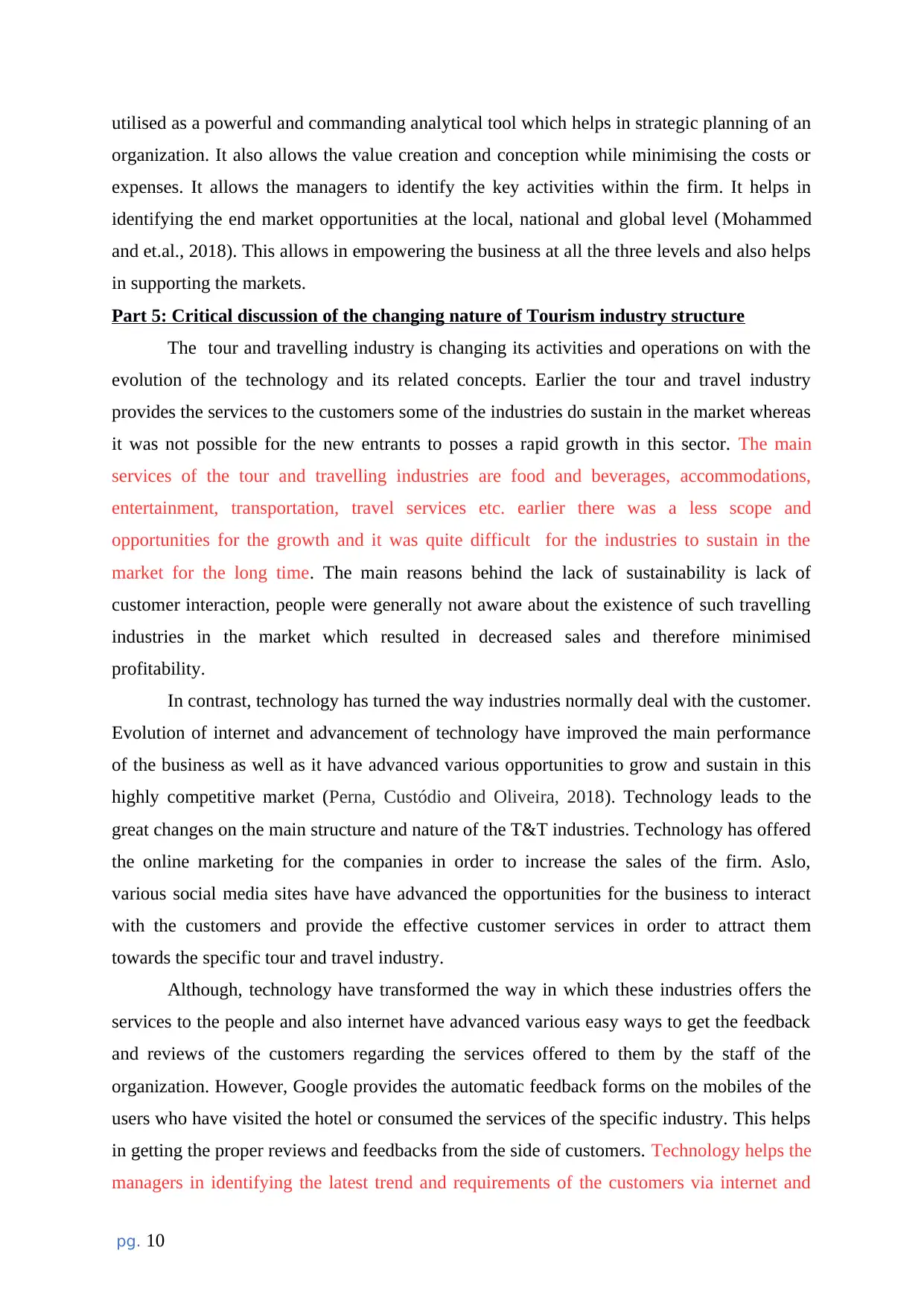
utilised as a powerful and commanding analytical tool which helps in strategic planning of an
organization. It also allows the value creation and conception while minimising the costs or
expenses. It allows the managers to identify the key activities within the firm. It helps in
identifying the end market opportunities at the local, national and global level (Mohammed
and et.al., 2018). This allows in empowering the business at all the three levels and also helps
in supporting the markets.
Part 5: Critical discussion of the changing nature of Tourism industry structure
The tour and travelling industry is changing its activities and operations on with the
evolution of the technology and its related concepts. Earlier the tour and travel industry
provides the services to the customers some of the industries do sustain in the market whereas
it was not possible for the new entrants to posses a rapid growth in this sector. The main
services of the tour and travelling industries are food and beverages, accommodations,
entertainment, transportation, travel services etc. earlier there was a less scope and
opportunities for the growth and it was quite difficult for the industries to sustain in the
market for the long time. The main reasons behind the lack of sustainability is lack of
customer interaction, people were generally not aware about the existence of such travelling
industries in the market which resulted in decreased sales and therefore minimised
profitability.
In contrast, technology has turned the way industries normally deal with the customer.
Evolution of internet and advancement of technology have improved the main performance
of the business as well as it have advanced various opportunities to grow and sustain in this
highly competitive market (Perna, Custódio and Oliveira, 2018). Technology leads to the
great changes on the main structure and nature of the T&T industries. Technology has offered
the online marketing for the companies in order to increase the sales of the firm. Aslo,
various social media sites have have advanced the opportunities for the business to interact
with the customers and provide the effective customer services in order to attract them
towards the specific tour and travel industry.
Although, technology have transformed the way in which these industries offers the
services to the people and also internet have advanced various easy ways to get the feedback
and reviews of the customers regarding the services offered to them by the staff of the
organization. However, Google provides the automatic feedback forms on the mobiles of the
users who have visited the hotel or consumed the services of the specific industry. This helps
in getting the proper reviews and feedbacks from the side of customers. Technology helps the
managers in identifying the latest trend and requirements of the customers via internet and
pg. 10
organization. It also allows the value creation and conception while minimising the costs or
expenses. It allows the managers to identify the key activities within the firm. It helps in
identifying the end market opportunities at the local, national and global level (Mohammed
and et.al., 2018). This allows in empowering the business at all the three levels and also helps
in supporting the markets.
Part 5: Critical discussion of the changing nature of Tourism industry structure
The tour and travelling industry is changing its activities and operations on with the
evolution of the technology and its related concepts. Earlier the tour and travel industry
provides the services to the customers some of the industries do sustain in the market whereas
it was not possible for the new entrants to posses a rapid growth in this sector. The main
services of the tour and travelling industries are food and beverages, accommodations,
entertainment, transportation, travel services etc. earlier there was a less scope and
opportunities for the growth and it was quite difficult for the industries to sustain in the
market for the long time. The main reasons behind the lack of sustainability is lack of
customer interaction, people were generally not aware about the existence of such travelling
industries in the market which resulted in decreased sales and therefore minimised
profitability.
In contrast, technology has turned the way industries normally deal with the customer.
Evolution of internet and advancement of technology have improved the main performance
of the business as well as it have advanced various opportunities to grow and sustain in this
highly competitive market (Perna, Custódio and Oliveira, 2018). Technology leads to the
great changes on the main structure and nature of the T&T industries. Technology has offered
the online marketing for the companies in order to increase the sales of the firm. Aslo,
various social media sites have have advanced the opportunities for the business to interact
with the customers and provide the effective customer services in order to attract them
towards the specific tour and travel industry.
Although, technology have transformed the way in which these industries offers the
services to the people and also internet have advanced various easy ways to get the feedback
and reviews of the customers regarding the services offered to them by the staff of the
organization. However, Google provides the automatic feedback forms on the mobiles of the
users who have visited the hotel or consumed the services of the specific industry. This helps
in getting the proper reviews and feedbacks from the side of customers. Technology helps the
managers in identifying the latest trend and requirements of the customers via internet and
pg. 10
Paraphrase This Document
Need a fresh take? Get an instant paraphrase of this document with our AI Paraphraser
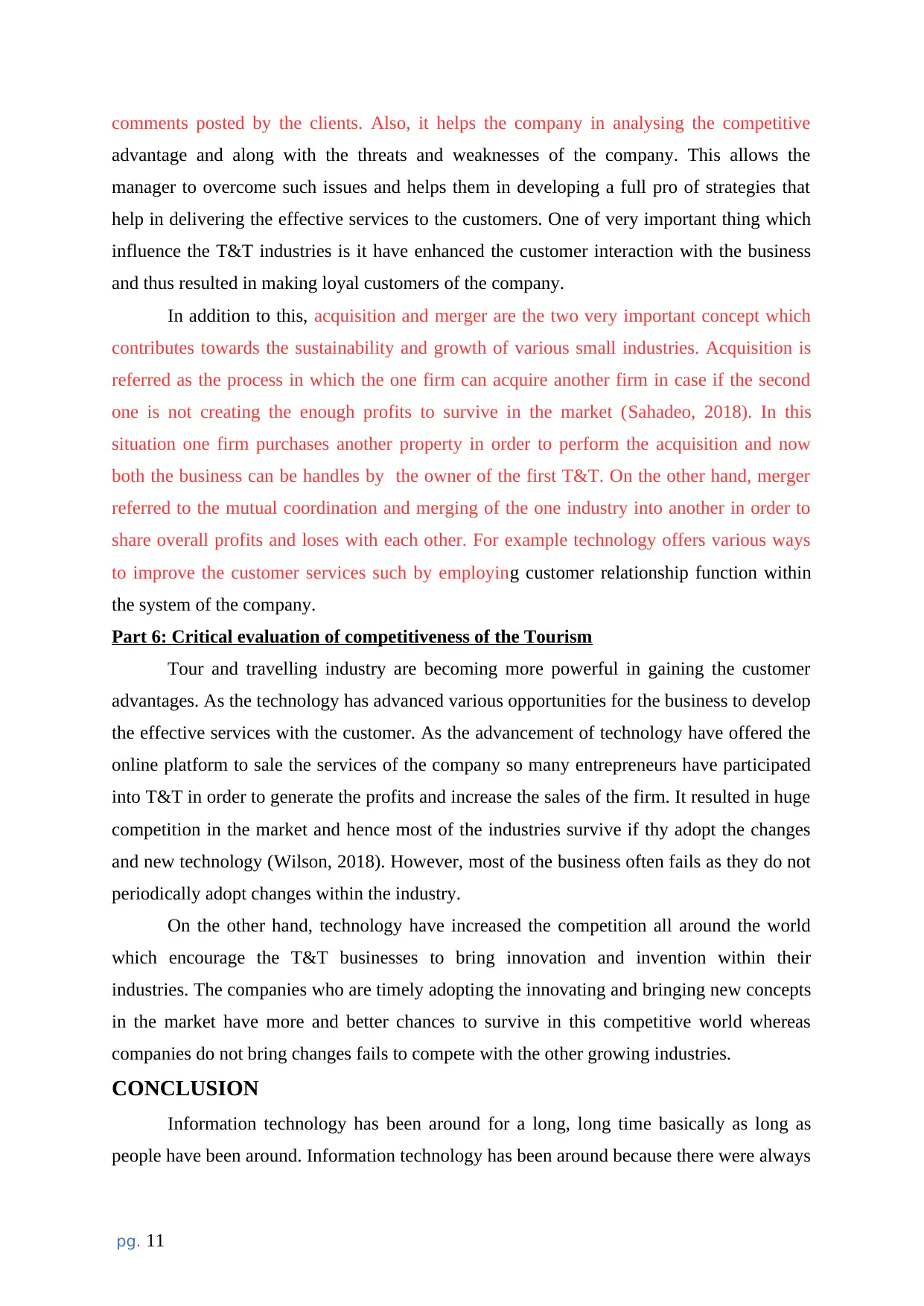
comments posted by the clients. Also, it helps the company in analysing the competitive
advantage and along with the threats and weaknesses of the company. This allows the
manager to overcome such issues and helps them in developing a full pro of strategies that
help in delivering the effective services to the customers. One of very important thing which
influence the T&T industries is it have enhanced the customer interaction with the business
and thus resulted in making loyal customers of the company.
In addition to this, acquisition and merger are the two very important concept which
contributes towards the sustainability and growth of various small industries. Acquisition is
referred as the process in which the one firm can acquire another firm in case if the second
one is not creating the enough profits to survive in the market (Sahadeo, 2018). In this
situation one firm purchases another property in order to perform the acquisition and now
both the business can be handles by the owner of the first T&T. On the other hand, merger
referred to the mutual coordination and merging of the one industry into another in order to
share overall profits and loses with each other. For example technology offers various ways
to improve the customer services such by employing customer relationship function within
the system of the company.
Part 6: Critical evaluation of competitiveness of the Tourism
Tour and travelling industry are becoming more powerful in gaining the customer
advantages. As the technology has advanced various opportunities for the business to develop
the effective services with the customer. As the advancement of technology have offered the
online platform to sale the services of the company so many entrepreneurs have participated
into T&T in order to generate the profits and increase the sales of the firm. It resulted in huge
competition in the market and hence most of the industries survive if thy adopt the changes
and new technology (Wilson, 2018). However, most of the business often fails as they do not
periodically adopt changes within the industry.
On the other hand, technology have increased the competition all around the world
which encourage the T&T businesses to bring innovation and invention within their
industries. The companies who are timely adopting the innovating and bringing new concepts
in the market have more and better chances to survive in this competitive world whereas
companies do not bring changes fails to compete with the other growing industries.
CONCLUSION
Information technology has been around for a long, long time basically as long as
people have been around. Information technology has been around because there were always
pg. 11
advantage and along with the threats and weaknesses of the company. This allows the
manager to overcome such issues and helps them in developing a full pro of strategies that
help in delivering the effective services to the customers. One of very important thing which
influence the T&T industries is it have enhanced the customer interaction with the business
and thus resulted in making loyal customers of the company.
In addition to this, acquisition and merger are the two very important concept which
contributes towards the sustainability and growth of various small industries. Acquisition is
referred as the process in which the one firm can acquire another firm in case if the second
one is not creating the enough profits to survive in the market (Sahadeo, 2018). In this
situation one firm purchases another property in order to perform the acquisition and now
both the business can be handles by the owner of the first T&T. On the other hand, merger
referred to the mutual coordination and merging of the one industry into another in order to
share overall profits and loses with each other. For example technology offers various ways
to improve the customer services such by employing customer relationship function within
the system of the company.
Part 6: Critical evaluation of competitiveness of the Tourism
Tour and travelling industry are becoming more powerful in gaining the customer
advantages. As the technology has advanced various opportunities for the business to develop
the effective services with the customer. As the advancement of technology have offered the
online platform to sale the services of the company so many entrepreneurs have participated
into T&T in order to generate the profits and increase the sales of the firm. It resulted in huge
competition in the market and hence most of the industries survive if thy adopt the changes
and new technology (Wilson, 2018). However, most of the business often fails as they do not
periodically adopt changes within the industry.
On the other hand, technology have increased the competition all around the world
which encourage the T&T businesses to bring innovation and invention within their
industries. The companies who are timely adopting the innovating and bringing new concepts
in the market have more and better chances to survive in this competitive world whereas
companies do not bring changes fails to compete with the other growing industries.
CONCLUSION
Information technology has been around for a long, long time basically as long as
people have been around. Information technology has been around because there were always
pg. 11
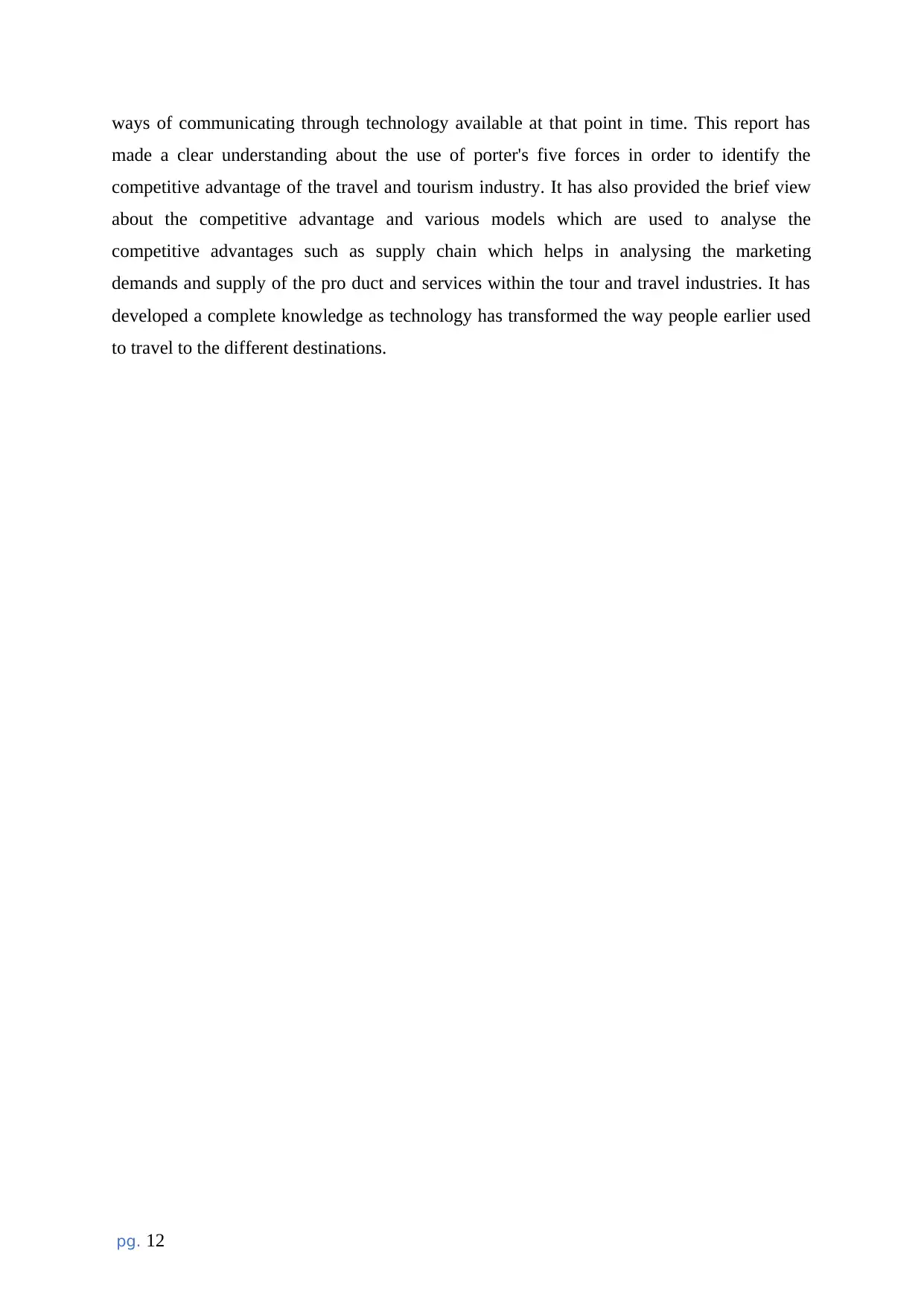
ways of communicating through technology available at that point in time. This report has
made a clear understanding about the use of porter's five forces in order to identify the
competitive advantage of the travel and tourism industry. It has also provided the brief view
about the competitive advantage and various models which are used to analyse the
competitive advantages such as supply chain which helps in analysing the marketing
demands and supply of the pro duct and services within the tour and travel industries. It has
developed a complete knowledge as technology has transformed the way people earlier used
to travel to the different destinations.
pg. 12
made a clear understanding about the use of porter's five forces in order to identify the
competitive advantage of the travel and tourism industry. It has also provided the brief view
about the competitive advantage and various models which are used to analyse the
competitive advantages such as supply chain which helps in analysing the marketing
demands and supply of the pro duct and services within the tour and travel industries. It has
developed a complete knowledge as technology has transformed the way people earlier used
to travel to the different destinations.
pg. 12
⊘ This is a preview!⊘
Do you want full access?
Subscribe today to unlock all pages.

Trusted by 1+ million students worldwide
1 out of 14
Related Documents
Your All-in-One AI-Powered Toolkit for Academic Success.
+13062052269
info@desklib.com
Available 24*7 on WhatsApp / Email
![[object Object]](/_next/static/media/star-bottom.7253800d.svg)
Unlock your academic potential
Copyright © 2020–2025 A2Z Services. All Rights Reserved. Developed and managed by ZUCOL.




